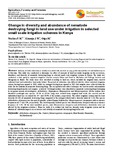| dc.contributor.author | Wachira, PM | |
| dc.contributor.author | Kimenju, JW | |
| dc.contributor.author | Otipa, M | |
| dc.date.accessioned | 2015-02-11T08:50:45Z | |
| dc.date.available | 2015-02-11T08:50:45Z | |
| dc.date.issued | 2015 | |
| dc.identifier.citation | Wachira, P. M., Kimenju, J. W., & Otipa, M. Change in diversity and abundance of nematode destroying fungi in land use under irrigation in selected small scale irrigation schemes in Kenya. | en_US |
| dc.identifier.uri | http://hdl.handle.net/11295/80210 | |
| dc.description.abstract | : Intensity of land cultivation is usually associated with increase in crop production and loss of soil biodiversity or
its function. This study was conducted to determine the effect of intensity of land use under irrigation on the occurrence,
abundance and diversity of nematode destroying fungi in selected small scale irrigation systems in Kenya. The study was
conducted in four spatially separated irrigation schemes namely Kabaa and Kauti in Machakos and Kathiga Gacheru and
Mbogooni) in Embu. The study areas were stratified according to land use, which included the irrigated land, rain-fed
cultivated land and undisturbed land under fallow. The period of cultivation also differed with the oldest cultivated irrigation
system, having been opened in 1960, while the youngest having been opened in 2011.Soil samples were collected from the
study site for isolation of nematode destroying fungi. The soil sprinkle and culture technique was used to isolate soil nematode
destroying fungi from the soil samples. A total of 216 fungal isolates were identified as nematode destroying fungi belonging
to six genera namely Acrostalagmus, Arthrobotrys, Haptoglossa, Harposporium and Monacrosporium. All the isolates were
identified resultingto nine species. 49.5% of all the fungi were isolated from irrigated land while, the rain-fed and the
undisturbed land uses accounted for 29.7 and 20.8% of the isolates, respectively. The oldest irrigation systems had the least
diversity (0.110) of nematode destroying fungi compared to the youngest which had a diversity index of 1.311.The species
Arthrobotrys oligospora was the most frequently isolated fungus followed by Monacrosporium cionapagum with occurrence
frequencies of 57 and 53%, respectively. The least frequently isolated species was Nematoctonus leiospora with an occurrence
frequency of 2.3%. Of the total identified species, only Nematoctonus leiosporus and Arthrobotrys dactyloides were not
affected by the irrigation activities.). From the study, it is evident that land use intensity under irrigation system and the
duration of cultivation impacts on occurrence and diversity of nematode destroying fungi in the soil. | en_US |
| dc.language.iso | en | en_US |
| dc.publisher | University of Nairobi | en_US |
| dc.subject | Arthrobotrys oligospora, Bio -Control, Monacrosporium cionopagum, Plant Parasitic Nematodes, Soil Biodiversity | en_US |
| dc.title | Change in diversity and abundance of nematode destroying fungi in land use under irrigation in selected small scale irrigation schemes in Kenya | en_US |
| dc.type | Article | en_US |
| dc.type.material | en_US | en_US |

